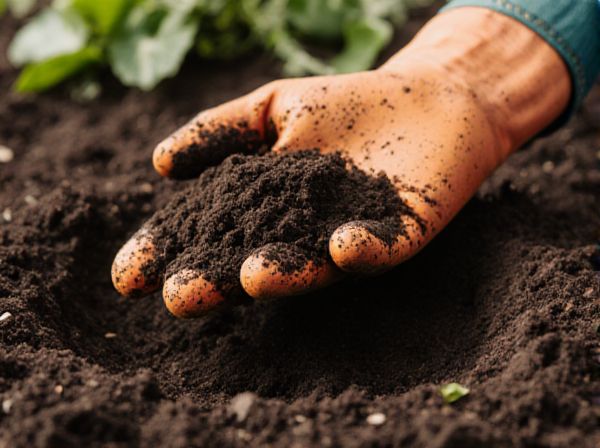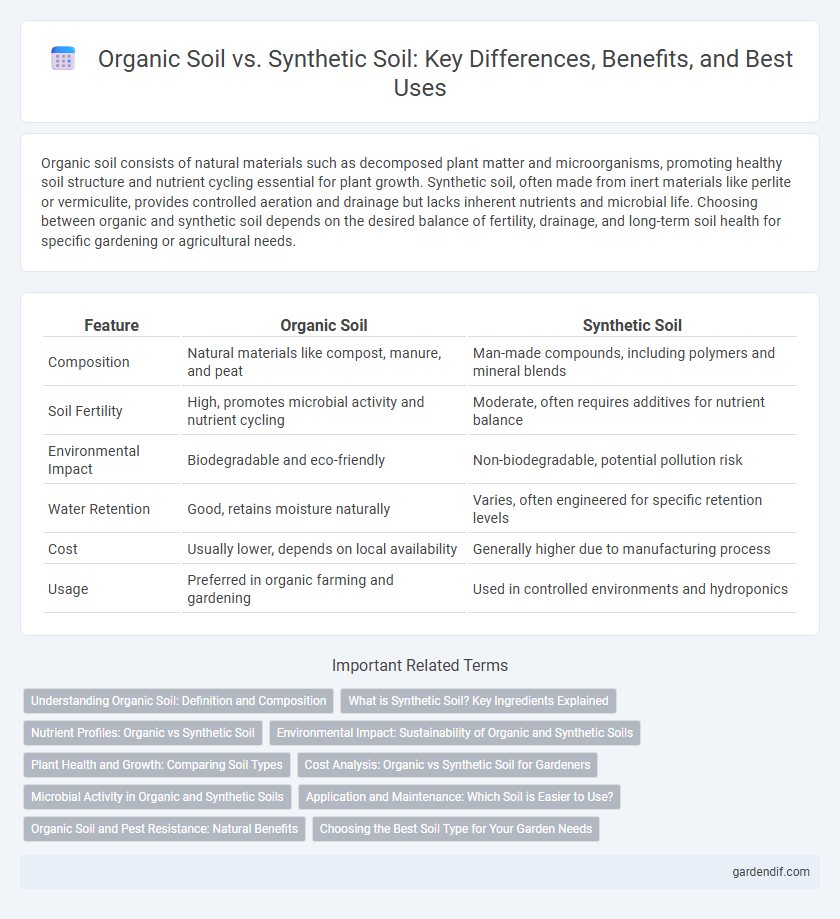
Organic Soil vs Synthetic Soil Illustration
Organic soil consists of natural materials such as decomposed plant matter and microorganisms, promoting healthy soil structure and nutrient cycling essential for plant growth. Synthetic soil, often made from inert materials like perlite or vermiculite, provides controlled aeration and drainage but lacks inherent nutrients and microbial life. Choosing between organic and synthetic soil depends on the desired balance of fertility, drainage, and long-term soil health for specific gardening or agricultural needs.
Table of Comparison
| Feature | Organic Soil | Synthetic Soil |
|---|---|---|
| Composition | Natural materials like compost, manure, and peat | Man-made compounds, including polymers and mineral blends |
| Soil Fertility | High, promotes microbial activity and nutrient cycling | Moderate, often requires additives for nutrient balance |
| Environmental Impact | Biodegradable and eco-friendly | Non-biodegradable, potential pollution risk |
| Water Retention | Good, retains moisture naturally | Varies, often engineered for specific retention levels |
| Cost | Usually lower, depends on local availability | Generally higher due to manufacturing process |
| Usage | Preferred in organic farming and gardening | Used in controlled environments and hydroponics |
Understanding Organic Soil: Definition and Composition
Organic soil consists primarily of decomposed plant and animal matter, rich in natural nutrients and microorganisms essential for healthy plant growth. Its composition includes a high percentage of humus, which improves soil structure, moisture retention, and aeration compared to synthetic soil alternatives. The presence of organic compounds and microbial activity in organic soil enhances nutrient cycling and supports sustainable agriculture.
What is Synthetic Soil? Key Ingredients Explained
Synthetic soil is an engineered growing medium composed primarily of inorganic materials such as perlite, vermiculite, and coconut coir, designed to provide optimal aeration, drainage, and nutrient retention for plant growth. Key ingredients include hydroponic-grade minerals, peat moss substitutes, and commercial-grade fertilizers that mimic natural soil's nutrient profile while minimizing contaminants and pathogens. Unlike organic soil, synthetic soil offers consistent chemical composition and enhanced control over pH and moisture levels, making it ideal for controlled environment agriculture.
Nutrient Profiles: Organic vs Synthetic Soil
Organic soil contains diverse, naturally occurring nutrients and beneficial microorganisms that enhance nutrient availability and soil health over time, promoting sustainable plant growth. Synthetic soil provides easily measurable, precisely balanced nutrient profiles tailored for immediate plant uptake, often lacking the complex biological interactions found in organic soils. Nutrient release from organic soil occurs gradually, while synthetic soil offers rapid nutrient availability but may require careful management to prevent leaching and nutrient imbalances.
Environmental Impact: Sustainability of Organic and Synthetic Soils
Organic soil enhances environmental sustainability through natural nutrient cycling, improved soil structure, and increased biodiversity by supporting microbial activity. Synthetic soil, often derived from non-renewable resources, can contribute to pollution and landfill waste due to its slow degradation and potential chemical leaching. The long-term use of organic soil promotes carbon sequestration and reduces the ecological footprint, making it a more sustainable choice than synthetic alternatives.
Plant Health and Growth: Comparing Soil Types
Organic soil, rich in natural nutrients and beneficial microorganisms, promotes robust plant health and sustainable growth by enhancing root development and nutrient uptake. Synthetic soil, often containing manufactured components, may provide initial nutrient availability but can lack the biological activity essential for long-term soil fertility and plant resilience. Studies show organic soil improves moisture retention and supports beneficial microbial ecosystems, directly contributing to stronger, healthier plants compared to synthetic alternatives.
Cost Analysis: Organic vs Synthetic Soil for Gardeners
Organic soil often involves higher upfront costs due to the need for natural amendments like compost and manure but provides long-term benefits through improved soil structure and microbial activity. Synthetic soil, typically composed of inert materials and chemical additives, usually has lower initial costs but may require frequent replacement and additional fertilizers, increasing expenses over time. Gardeners prioritizing sustainability may find organic soil more cost-effective in the long run despite the initial investment.
Microbial Activity in Organic and Synthetic Soils
Organic soil supports higher microbial activity due to its abundant natural organic matter, which serves as a food source for diverse microbes including bacteria, fungi, and protozoa. Synthetic soil, often lacking organic content, exhibits reduced microbial diversity and slower nutrient cycling, limiting soil fertility and ecosystem functions. Enhanced microbial populations in organic soils promote nutrient availability, soil structure, and plant growth through complex biochemical processes.
Application and Maintenance: Which Soil is Easier to Use?
Organic soil requires regular monitoring of nutrient levels and moisture to maintain its natural fertility, making it ideal for sustainable gardening practices but demanding more hands-on care. Synthetic soil, often engineered for specific plant needs, offers consistent texture and nutrient content, reducing the frequency of maintenance and simplifying application for rapid growth. Choosing between organic and synthetic soil depends on the gardener's priority for ease of use versus long-term soil health and environmental impact.
Organic Soil and Pest Resistance: Natural Benefits
Organic soil enhances pest resistance through its rich composition of beneficial microorganisms that suppress harmful pests and diseases naturally. The presence of organic matter improves soil structure and nutrient availability, fostering healthier plant growth and stronger immune responses. This natural balance reduces the need for chemical pesticides, contributing to sustainable and eco-friendly agricultural practices.
Choosing the Best Soil Type for Your Garden Needs
Organic soil enhances garden health by providing natural nutrients, improving soil structure, and supporting beneficial microbial activity essential for plant growth. Synthetic soil offers consistent texture and drainage properties, allowing precise control over nutrient delivery and moisture levels, ideal for specialized or container gardening. Selecting the best soil type depends on factors such as plant species, garden environment, and desired maintenance, balancing nutrient availability with soil aeration and water retention.
Organic Soil vs Synthetic Soil Infographic

 gardendif.com
gardendif.com